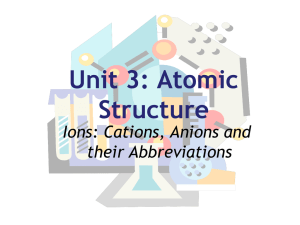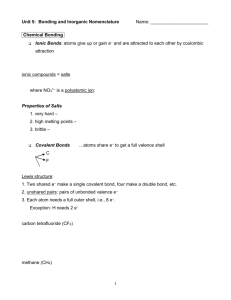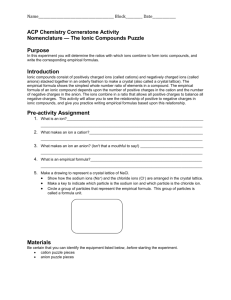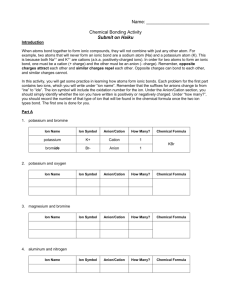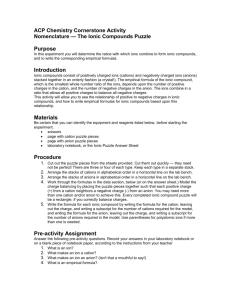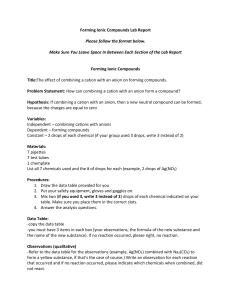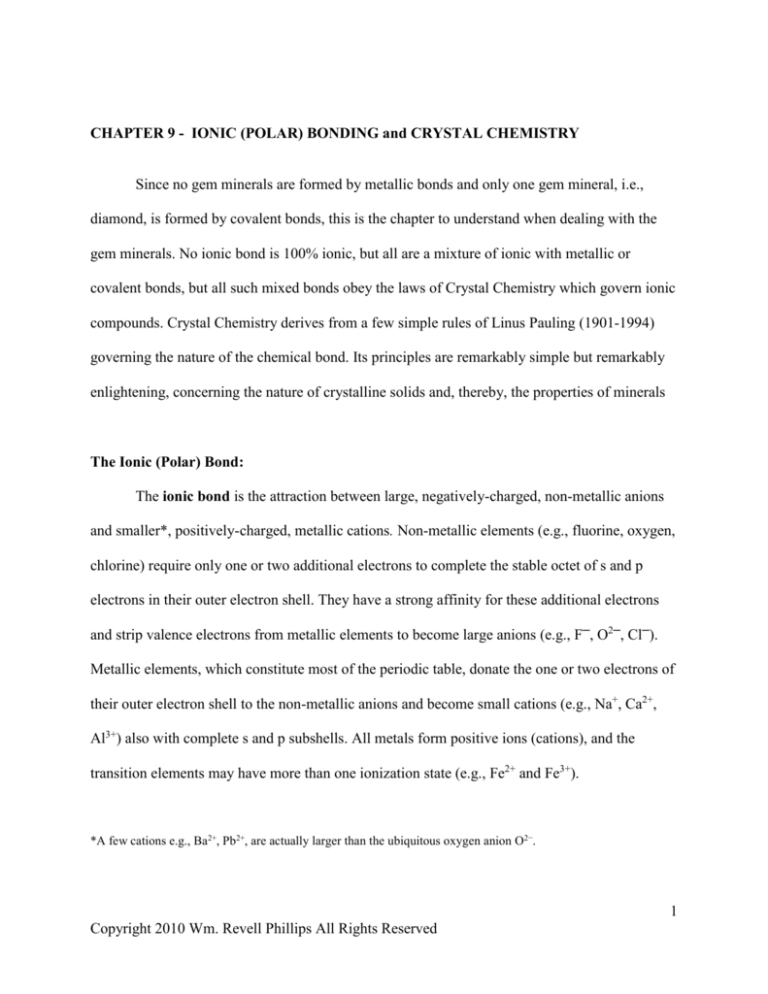
CHAPTER 9 - IONIC (POLAR) BONDING and CRYSTAL CHEMISTRY
Since no gem minerals are formed by metallic bonds and only one gem mineral, i.e.,
diamond, is formed by covalent bonds, this is the chapter to understand when dealing with the
gem minerals. No ionic bond is 100% ionic, but all are a mixture of ionic with metallic or
covalent bonds, but all such mixed bonds obey the laws of Crystal Chemistry which govern ionic
compounds. Crystal Chemistry derives from a few simple rules of Linus Pauling (1901-1994)
governing the nature of the chemical bond. Its principles are remarkably simple but remarkably
enlightening, concerning the nature of crystalline solids and, thereby, the properties of minerals
The Ionic (Polar) Bond:
The ionic bond is the attraction between large, negatively-charged, non-metallic anions
and smaller*, positively-charged, metallic cations. Non-metallic elements (e.g., fluorine, oxygen,
chlorine) require only one or two additional electrons to complete the stable octet of s and p
electrons in their outer electron shell. They have a strong affinity for these additional electrons
and strip valence electrons from metallic elements to become large anions (e.g., F─, O2─, Cl─).
Metallic elements, which constitute most of the periodic table, donate the one or two electrons of
their outer electron shell to the non-metallic anions and become small cations (e.g., Na+, Ca2+,
Al3+) also with complete s and p subshells. All metals form positive ions (cations), and the
transition elements may have more than one ionization state (e.g., Fe2+ and Fe3+).
*A few cations e.g., Ba2+, Pb2+, are actually larger than the ubiquitous oxygen anion O2−.
1
Copyright 2010 Wm. Revell Phillips All Rights Reserved
Ionic bonds are neither limited in number nor direction and act uniformly in all directions
upon all surrounding ions of opposite charge. Ionic bonds form no molecules but, rather a
continuous, three-dimensional, and space-efficient crystal structure of different size ions.
The attraction force (F) between the negative anion and the positive cation. i.e., bond
strength, increases with the charge on the anion (ea) and the charge on the cation (ec) and
decreases with the size of the anion and the size of the cation, i.e., the radius of the anion plus the
radius of the cation (ra + rc).
𝑒
F ≈ (𝑟𝑎 ∙
𝑒𝑐
𝑎+ 𝑟𝑐 )
Small ions with large electrical charge (e.g., Si4+, Al3+ and Be2+) favor strong ionic bonding and
hard minerals. Corundum (Al2O3) and beryl [Be3Al2(SiO3)6] are hard gem minerals. Orthoclase
(KSi3AlO8) is softer owing to the large K+ cation.
Elecronegativity:
No bond between cation and anion is totally ionic; and the ionic character of the bond is
determined by the desire of the anion to gain electrons and the willingness of the cation to donate
them. Electronegativity is the affinity of an atom for electrons, and the electronegativity
difference between anion and cation defines the ionic percentage of the bond (See Table 9-1).
Halide elements (e.g., fluorine, chlorine) have the highest affinity for electrons and the largest
electronegativity, and alkali elements (e.g., lithium, sodium, potassium) have the lowest affinity
for electrons and the smallest electronegativity. Alkali-halides (e.g., NaCl, KF, etc.) are,
therefore, the most ionic compounds. The electronegativity difference between fluorite and
potassium is 3.2 and the bond between them is about 90% ionic. The carbon-oxygen bond and
the sulfur-oxygen bond are about 20% ionic and the CO32─ and SO42─ units are largely covalent
complex ions which may be considered as odd-shaped anions in ionic structures. The silicon2
Copyright 2010 Wm. Revell Phillips All Rights Reserved
oxygen bond is only 40% ionic, however, silicate minerals will be treated as ionic compounds.
Non-metallic elements have large electronegativity and tend to form large, negative ions
(anions); and metallic elements have small electronegativity and tend to form small positive ions
(cations).
Physical Properties:
Hardness, melting point and water solubility of ionic compounds depend upon bond
strength (i.e., ion size and charge). MgO is harder and has a higher melting point than CaO
because Mg2+ is smaller than Ca2+. MgO is harder and has a higher melting point than LiF even
though Mg2+ is the same size as Li+ and O2─ is slightly larger than F─. Double charge makes for
harder compounds than single charge. Halides (e.g., NaCl) tend to be soft and water soluble,
oxides (e.g., MgO) are harder and less soluble.
Ionic compounds are not electrical conductors in the solid state but are good conductors
when molten or in water solution where electrically charged cations and anions are free and able
to flow toward electric poles.
Ionic structures tend to be transparent and colorless, unless they contain transition
elements or structural imperfections (i.e., color centers), either of which may absorb some range
of visible light wavelengths (See Chapter 6). The index of refraction of simple ionic structures of
common light elements is low compared to that of covalent or metallic structures, and the luster
of ionic compounds is vitreous (i.e., glass-like) compared to the adamantine (i.e., diamond-like)
luster of covalent structures or the metallic luster of metals. Very heavy ions (e.g., Pb+2, Ba+2,
U+6) may introduce high electron density to ionic compounds and, hence, large refraction index
and adamantine luster.
3
Copyright 2010 Wm. Revell Phillips All Rights Reserved
Ionic Radius and Coordination Number - (See Table 9-2 for ionic radii)
The size of an ion is expressed by its radius cited in angstroms (1Å = 108 cm.). An ion is
not a “steel ball” but is often presented as a miniature “solar system” where the ion volume is
largely empty space and electron shells can contract with increasing positive charge in the atom
nucleus or with compressional force.
Cation size (i.e., radius) increases from top to bottom on the periodic table, as new
electron shells are added (Li+ = 0.82 Å, Na+ = 1.10 Å, K+ = 1.46 Å, Rb+ = 1.57 Å, Cs+ = 1.78 Å).
Ion size decreases from left to right on the periodic table, as protons are added to the atom
nucleus (Na+ = 1.10 Å, Mg2+ = 0.80 Å, Al3+ = 0.61 Å, Si4+ = 0.48 Å, P5+ = 0.25 Å).* Ion size
decreases as ionization state increases (Fe2+ = 0.86 Å, Fe3+ = 0.73 Å). Ion size increases with its
coordination number (i.e., the number of anions which surround it) (Al3+ in four-fold
coordination = 0.47 Å, Al3+ in six-fold coordination = 0.61 Å).
*The elements sulfur, chlorine and argon complete the second row of the periodic table. As a cation, sulfur is small
(S4+) and appears in the complex sulfate ion (SO42−). Sulfur is more commonly an anion which is large (S 2− = 1.56
Å) and is the anion of the sulfide minerals (e.g., FeS). Chlorine is always a large anion (Cl− = 1.67 Å), and argon
never forms ions either anion or cation.
Cations of transition elements are roughly the same size and most appropriate for sites of
six-fold (octahedral) coordination. The positive charge of a proton added to the nucleus of a
transition element atom is roughly offset by a negative charge of an electron added, not to the
outermost electron shell, but to the next shell nearer the nucleus.
Ions of the rare earth elements actually decrease in size as protons are added to the
nucleus and corresponding electrons are added two shells below the outer shell. This is called the
“Lanthanide contraction” and causes the transition elements of the 5th row of the periodic table
4
Copyright 2010 Wm. Revell Phillips All Rights Reserved
to be roughly the same size, or even smaller, than those of the row above them (e.g., Hf4+ is
slightly smaller than Zr4+).
Anions are large and constitute, by volume, about 90% of most mineral structures. The
oxygen anion (O2─) is, by far, the most abundant anion and most mineral structures are
essentially a framework of large, spherical oxygen anions with small, spherical cations located
in cavities between them.
The number of anions in contact with a cation is the coordination number of the cation
(Figure 9-2). Surrounding any given cation, the anions are usually arranged as a regular
polyhedron, where the anion centers are at the points of a tetrahedron (four-fold coordination),
octahedron (six-fold coordination) or cube (eight-fold coordination), with the cation at its
center. The larger the cation, the more anions that can surround it, hence, the larger the
coordination number of the cation. The coordination number is always a whole number and
usually four, for small cations, six, for medium size cations, and eight, for large cations.†
†Other coordination numbers are possible and not especially unusual, but four, six and eight will serve our purpose.
Very tiny cations, like C4+ in the CO32─ carbonate ion may have three-fold coordination (see Page ), and very large
cations which are comparable in size to the anions, like K+, may have twelve-fold coordination, which is the
coordination of every atom in a cubic close packed or hexagonal close packed structure (see Page ).
Oxygen ions, of radius 1.32 Å, arranged at the corners of a regular tetrahedron (i.e., fourfold coordination), will leave a central cavity which will exactly accommodate a sphere (i.e.,
cation) of radius 0.30Å. Oxygen ions at the corners or a regular octahedron (i.e., six-fold
coordination) will provide a central cavity to exactly accommodate a sphere of radius 0.55 Å; and
oxygen ions at the corners of a regular cube (i.e., eight-fold coordination) will leave a central
5
Copyright 2010 Wm. Revell Phillips All Rights Reserved
cavity to exactly accommodate a sphere of radius 0.97 Å.
.
Cations are seldom smaller than the cavity they occupy and are usually larger than the
ideal size (See Table 9-2) indicated in the previous paragraph where anions are assumed to
contact one another. The mutual repulsion of negative oxygen anions allows cations to enter a
four-fold site having a size range from the ideal radius (0.30 Å) up to the ideal radius for the sixfold coordination site (0.55 Å). The following table indicates the expected coordination number
for those metal cations common in gem minerals, where the anion is assumed to be oxygen
(O2─).
Let us repeat that ions are not “steel balls” but may expand and contract within limits,
and cations are usually somewhat larger than the ideal coordination site they occupy. Other
factors may influence the coordination number of a cation in a crystal structure and there are
some exceptions to the simple “rules” outlined above.
Ion Substitution:
A mineral species is defined by its crystal structure (atom arrangement) and its chemical
composition. Minerals that have the same chemical composition but different crystal structures
are called polymorphs (Gr. poly= many and morphe= form).For example diamond (isometric)
and graphite (hexagonal), which are both pure carbon, calcite (trigonal) and aragonite
(orthorhombic) which are both CaCO3 , or cubic zirconia (isometric) and baddeleyite
(monoclinic) which are both ZrO2.
Minerals which have the same crystal structure but different chemical composition are
called isomorphs (Gr. isos= equal, and morphe= form). For example: spinel (MgAl2O4) and
chromite (FeCr2O4), or corundum (Al2O3) and hematite (Fe2O3). Some isomorphs form an
6
Copyright 2010 Wm. Revell Phillips All Rights Reserved
isomorphous series, or solid solution, series, where one element substitutes for another in a
continuous composition series. For example, the olivine series (peridot) which may range
continuously in composition from series end-member forsterite (Mg2SiO4) to series endmember fayalite (Fe2SiO4) where the Mg2+ ion is replaced completely or in any ratio by the Fe2+
ion. For such complete replacement the exchanging cations must have very similar size (Mg2+ =
0.82 Å and Fe2+ = 0.86 Å) and must maintain electrical balance (Mg2+ and Fe2+ have the same +2
charge). Natural peridot is usually magnesium-rich but will contain some iron, which accounts
for its range of color, indices of refraction, and other physical properties.
Where the size difference in the exchanging cations is somewhat greater, only a partial
solid solution may result. For example: isomorphs albite (NaSi3AlO8) and microcline
(KSi3AlO8) feldspars form a partial solid solution, where Na+ (1.24 Å) and K+ (1.59 Å) do not
replace one another in all proportions. Natural albite (NaSi3AlO8) will, however, contain some
potassium and natural orthoclase (KSi3AlO8) will contain some sodium. Very high temperatures,
where atoms are in great agitation, allow a greater range of replacement, and Na+ and K+ may
completely replace one another at high temperatures to form a complete solid solution series. As
this hybrid crystal cools, however, it separates into alternating layers of sodium-rich and
potassium-rich feldspar stacked parallel to a simple crystallographic plane (Figure 9-3). This
process is called exsolution and takes place by ion diffusion in the solid state much as oil
separates in a water solution. These microscopically thin, alternating layers of slightly different
composition may act as a diffraction grating to disperse light, and may produce phenomena like
the adularescence of moonstone.
Coupled substitution is the replacement of two different cations in a crystal structure
7
Copyright 2010 Wm. Revell Phillips All Rights Reserved
with another pair of cations while maintaining electrical charge balance. For example: albite
(NaSi3AlO8) and anorthite (CaSi2Al2O8) feldspars are the end-member compositions of the
plagioclase feldspar series which is a complete solid solution series. Replacement of Na+ (1.10
Å)
ions by Ca2+ (1.08 Å) ions requires coupled substitution of Si4+ (0.34 Å) by Al3+ (0.47 Å) to
maintain charge balance. Na+ and Ca2+ are very similar size and may completely replace one
another, however, Si4+ and Al3+ differ considerably in size and Al3+ never replaces more than
50% of the Si4+ cations.
Nearly all minerals contain trace amounts of elements which are not essential to the
formation of that mineral and not shown in its chemical formula. The substituting cations of such
foreign elements must be similar in size to the cations they replace and they must retain the
electrical charge balance. A few cations of some transition element may replace a few essential
cations bringing color to minerals which are otherwise colorless when pure. Minor Fe3+
substitution for Al3+ in octahedral coordination commonly yields pale yellow or yellow-green
crystals, but Cr3+ substitution for Al3+ gives the most beautiful and intense gem colors, like ruby
red and emerald green. Some minor ion replacement may be coupled to retain charge balance.
For example, one Ti4+ and one Fe2+ replacing two Al3+ in corundum (Al2O3) makes sapphire
blue.
Electrostatic Bond Principle:
In a stable coordinated crystal structure, the total strength of the electrostatic valency
bonds which reach an anion from all neighboring cations is equal to the charge on the anion.
Let us define the electrostatic valency bond which exists between a cation and an anion as the
8
Copyright 2010 Wm. Revell Phillips All Rights Reserved
charge on the cation (ec) divided by the coordination number of the cation (CNc), i.e.,
Electrostatic valency = ec/CNc. This useful principle allows us to organize and group ionic
mineral structures, especially the silicate minerals.
The Silicate Minerals:
The silicon-oxygen bond* is almost unique in the mineral kingdom because the
electrostatic valency of the bond is exactly one-half the charge on the oxygen anion. The silicon
cation Si4+ in ionic structures is always in four-fold, tetrahedral, coordination with oxygen
anions to form the silica tetrahedron (Figure 9-1). The electrostatic valency of the bond is 4/4 =
1 or exactly one-half the negative charge of the oxygen anion O2─. An oxygen anion bonded to
two silicon cations is completely neutralized and is called a bridging oxygen.
*The silicon-oxygen bond is only about 40% ionic and 60% covalent. If this bond is viewed as covalent, the silicon
atom forms four sp3 covalent bonds directed toward the corners of a tetrahedron, like the carbon atoms in diamond.
Viewed as an ionic bond, the Si+4 cation is the proper size for tetrahedral coordination with O2─ anions, so either the
covalent or the ionic paradigm yields the silica tetrahedron, which is the basic, stable unit of all silicate structures.
The chemical compound SiO2 is called silica. The most abundant minerals and most gem
minerals are silicates, meaning silica tetrahedra bonded to a variety of metal cations. To organize
the silicate minerals, let us note that, of the four oxygen anions which surround a silicon cation in
the silica tetrahedron, that none, one, two, three or all four may be bridging oxygens, and let us
define major silicate mineral groups based on that principle.
9
Copyright 2010 Wm. Revell Phillips All Rights Reserved
No Bridging Oxygens -Orthosilicates (Gr. orthos= straight) – Figure 9-4
Si:O ratio
1:4
Formula Unit
SiO44─
Examples
Mg2SiO4 (Peridot), ZrSiO4 (Zircon),
Mg3Al2(SiO4)3 (Pyrope), Al2(SiO4)(F,OH)2 (Topaz
If none of the oxygen anions in any silica tetrahedron is bridging, the silicate structure is
an orthosilicate, and every oxygen anion is bonded to one silicon cation and two or more other
cations (e.g., Figure 9-4). Every silica tetrahedron is an independent SiO44─ unit not sharing a
bridging oxygen with any other SiO44─ unit. The Si:O ratio is 1:4 as expressed in the chemical
formula for zircon (ZrSiO4) or peridot (Mg2SiO4).
One Bridging Oxygen - Sorosilicates (Gr. soros = box) – Figure 9-5
Si:O ratio
2:7
Formula Unit
Si2O76─
Examples
Ca2MgSi2O7 (Akermanite),
Ca2Al3O.SiO4.Si2O7.OH (Zoisite - Tanzanite)
If one of the oxygen anions is bridging, the three remaining oxygen anions of each silica
tetrahedron are free to bond to other cations and the silicate structure is a sorosilicate with Si:O
ratio 2:7, as expressed in the chemical formula for thortveitite [Sc2(Si2O7)]. The Si2O76─ units
(Figure 9-5) are also independent structural elements consisting of two silica tetrahedra sharing
one tetrahedron corner (i.e., bridging oxygen).
Two Bridging Oxygens - Single Chain Silicates [Inosilicates (Gr. inos = fiber)] – Figure 9-6
Si:O ratio
Formula Unit
1:3
SiO32─
Examples (Pyroxenes)
NaAl(SiO3)2 (Jadeite), LiAl(SiO3)2 (Spodumene),
10
Copyright 2010 Wm. Revell Phillips All Rights Reserved
CaMg(SiO3)2 Diopside, MnCa(SiO3)2 (Rhodonite)
If two oxygen anions of each silica tetrahedron are bridging, the silicate structure is a
single-chain silicate or ring silicate and only two remaining oxygen anions of each silica
tetrahedron can bond to outside cations. The Si:O ratio is 1:3 for an infinite single chain of silica
tetrahedra sharing two comers and 4:11 for a double chain. Chain silicates tend to form fibrous
or elongated crystals like jadeite (NaA1(SiO3)2], which is a gem mineral only because fibrous
crystals form a tough, interwoven aggregate. Some pyroxenes (e.g., spodumene and diopside)
form blocky crystals, but all pyroxenes and amphiboles have distinct {110} cleavages and
potential parting.
Two and One-half Bridging Oxygens - Double Chain Silicates (Inosilicates) – Figure 9-7
Si:O ratio
Formula Unit
4:11
Si4O116─
Examples (Amphiboles)
Ca2(Mg, Fe)5(Si4O11)2(OH)2 (Actinolite - Nephrite)
The silicate double chain is essentially two parallel single chains united by bridging
oxygen anions shared between the two chains. This creates two types of tetrahedra where every
other one along the chain shares three bridging oxygens. The amphibole minerals are always
hydrated with OH− anions filling open spaces along the long axis of the chain. Amphibole chains
are elongated on the c-crystallographic axis are stacked like those of the pyroxenes having the
same prismatic {110} cleavages and the same potential for parting. Pyroxene prismatic cleavages
intersect at near 90° but the amphibole prismatic cleavages intersect at 124° due to the width of
the double chain.
Two Bridging Oxygens - Ring Silicates [Cyclosilicates (Gr. cyclo = circular)] – Figure 9-8
11
Copyright 2010 Wm. Revell Phillips All Rights Reserved
Si:O ratio
Formula Unit
1:3
SiO32─
Examples
BaTi(SiO3)3 (Benitoite), Be3Al2(SiO3)6 (Beryl),
Na(Li,Al)3Al6(SiO3)6(BO3)3(F,OH)4 (Tourmaline)
A chain need not be straight, and silicate chains often form rings of three, four or six
silica tetrahedra (Figure 9-8). These rings are usually stacked vertical, parallel to the ccrystallographic axis of a uniaxial crystal, and the ring symmetry commonly defines the overall
symmetry of the crystal. Six-fold rings [(SiO3)6] are most common and are present in hexagonal
crystals like beryl [Be3Al2(SiO3)6] or trigonal crystals like tourmaline
[Na(Li,A1)3Al6(SiO3)6(BO3)3(OH, F)4] (Figure 9-9). The benitoite [BaTi(SiO3)3] structure
contains three-fold rings (Figure 9-8A) and forms triangular crystals of trigonal symmetry*.
Axinite [(Ca,Fe,Mn)3Al2BO3(SiO3)4OH] contains four-fold rings but is triclinic.
*Benitoite crystals have trigonal symmetry, but are technically a rare class of the hexagonal system.
Three Bridging Oxygens - Sheet Silicates [Phyllosilicates (Gr. phyllo = leaf)] – Figure 9-10
Si:O ratio
2:5
Formula Unit
Si2O52─
Examples (Micas and Clays)
KAl2(Si3Al)O10(OH)2 (Muscovite Mica),
Al2(Si2O5)(OH)4 (Kaolin Clay)
If three oxygen anions are bridging, the silicate structure is a sheet silicate and only one
oxygen anion in each silica tetrahedron can form bonds with other cations. The Si:O ratio is 2:5
or 4:10, as in the formula of serpentine [Mg3Si2O5(OH)4]. In sheet silicates, the aluminum cation
(Al3+) often plays its unique role, appearing in both tetrahedral and octahedral coordination. In
the common micas, muscovite [KAl2(Si3Al)O10(OH)2] for example, one of four Si4+ is replaced
by Al3+ in tetrahedral coordination*, and Al3+ also appears in octahedral coordination. The sheet
12
Copyright 2010 Wm. Revell Phillips All Rights Reserved
silicates, as the name implies, are minerals with sheet-like form. Micas, talcs and chlorites may
form extensive flat sheets, where the clays and serpentines normally form aggregates of tiny
flakes. No sheet silicate is really appropriate for gem purposes.
In some phyllosilicates Al3+ cations may replace Si4+ cations up to 50%, e.g., margarite
[Ca2Al4(Si4Al4)O20(OH)4].
Four Bridging Oxygens - Framework Silicates [Tektosilicates (Gr. tekton = build)]
Figure 9-11
Si:O ratio
1:2
Formula Unit
SiO2
Examples (Quartz and Feldspar)
SiO2 (Quartz), K(Si3Al)O8 (Orthoclase),
(Na,Ca)8(Al6Si6)O24(S2) (Lazurite - Lapis Lazuli)
.If
all four oxygen anions of the silica tetrahedron are bridging, no oxygen is available to
bond to other cations, and the mineral is quartz (SiO2). This is a framework silicate (Figure 911) since, with four bonds, the structure can build in three dimensions. Quartz and its SiO2
polymorphs (e.g., cristobalite) would be the only possible framework silicates were it not for the
substitution of Al3+ for Si4+ in some SiO44─ tetrahedra. If one of four Si4+ cations is replaced by
Al3+, one additional positive charge is needed to balance the framework structure, which is
introduced as an alkali cation (Na+ or K+) in the alkali feldspars. Albite [Na(Si3Al)O8] is the
sodium feldspar, and orthoclase [K(Si3Al)O8] and its polymorphs (microcline, adu1aria) are the
potassium feldspars. If two of four Si4+ cations are replaced by Al3+, two additional positive
charges are necessary to balance the structure, which are introduced as Ca2+ or Ba2+ ions.
Anorthite [Ca(Si2Al2)O8] is the calcium feldspar isomorph.
13
Copyright 2010 Wm. Revell Phillips All Rights Reserved
Zeolites, feldspathoids and ultramarines are also framework silicates made possible by
the substitution of Al3+ for Si4+ in the silica tetrahedral. This substitution never exceeds 50% in
any silicate mineral.
The Oxide and Halide Minerals:
In the non-silicate minerals the electrostatic valency of all cation-anion bonds is either
less than or greater than one-half the charge on the anion*.
Where the electrostatic valency of all bonds in a mineral structure is less than one-half
the anion charge, every anion must be bonded to more than two cations. Consider rutile (TiO2)
as an example. The electrostatic valency of the bond between the Ti4+ cation and the O2─ anion is
4/6 = 2/3, as the titanium ion is in the expected six-fold (octahedral) coordination. Each oxygen
anion is therefore bonded to three titanium ions, i.e., 3 × 2/3 = 6/3 = 2 (charge on O2─).
* The borate minerals are like the silicates, in that the boron-oxygen bond uses one-half the charge of the oxygen
anion. The B3+ cation can form only three ionic bonds, however. Chain borates and sheet borates do exist, but no
three-dimensional, ionic borate structures are possible.
The simple oxide and halide crystal structures tend to be close pack structures of oxygen
anions, either cubic close pack (ABCABC...stacking) or hexagonal close pack
(ABABAB...stacking), with smaller cations in voids between the closest pack oxygen layers.
Between two close pack layers of O2─ anions there are voids of six-fold (octahedral)
coordination and voids of four-fold (tetahedral) coordination available for cation occupation.
There are as many octahedral sites as anions in one close pack layer and twice as many
14
Copyright 2010 Wm. Revell Phillips All Rights Reserved
tetrahedral sites, but tetrahedral sites are usually empty and even the octahedral sites may not be
fully occupied. Halite (common NaCl salt) is cubic close pack structure of Cl− anions with Na+
cations in every octahedral void† (Figure 9-12).
† The chlorine anion is considerably larger than the oxygen anion and thus the octahedral void is also larger to
accommodate sodium cations, or even, potassium cations to form sylvite KCl.
Corundum (ruby and sapphire) (Al2O3) is trigonal, and its crystal structure is hexagonal
close pack O2─ anions, with Al3+ cations in two-thirds of the octahedral sites available between
any two closest packed layers of O2─. Because the Al3+ cation is small with a large charge, and
the structure is closest pack, corundum is hard and heavy. Stacking errors (e.g.,
ABABABCABAB…) produce multiple twinning and the accompanying distinct parting on
{0001}. Corundum is colorless unless (Cr3+), (Fe3+) or (Fe2+ and Ti4+) substitute for a few Al3+
cations to give color. Hematite (Fe2O3) and ilmenite (FeTiO3) are corundum polymorphs, but
these are essentially opaque, due to transition elements which are essential to the mineral.
Spinel (MgAl2O4) is isometric and its crystal structure is essentially cubic close pack
with cations in both octahedral and tetrahedral sites between the close pack layers. Its properties
are much like those of corundum, and it is colored by the same transition element impurities. A
variety of foreign cations may substitute for either Mg2+ or Al3+, and several combinations may
produce “black” spinel. Spinel forms under the same geological conditions as corundum, but
requires the presence of some magnesium, perhaps a dolomite host rock. Spinel may occur in the
same host rock with corundum. Spinel is a major mineral group. Chromite (FeCr2O4) and
magnetite (Fe2+Fe3+2O4) are spinels and contain two transition elements as essential components
15
Copyright 2010 Wm. Revell Phillips All Rights Reserved
making them black and opaque.
Chrysoberyl (Al2BeO4) is an isomorph of the orthosilicate olivine (Mg2SiO4).
Minerals with Complex Anions:
Where the electrostatic valency of one anion-cation bond in the mineral structure
exceeds one-half the anion charge, each anion (O2─) can only make one such bond, which leads
to the formation of the largely covalent, complex anions of the carbonates (CO32─) e.g., MnCO3
(rhodochrosite) and Cu2(OH)2CO3 (malachite); sulfates (SO42─) e.g., BaSO4 (barite); and
phosphates (PO43─) e.g., Ca5(PO4)3(F,OH) (apatite) and CuAl6(PO4)4(OH)8.4H2O (Turquoise).
Consider calcite (CaCO3), where the oxygen anion (O2─) bonds to both the carbon cation (C4+)
and the calcium cation (Ca2+). The electrostatic valency of the oxygen-carbon bond is 4/3, as the
carbon (C4+) cation is in three-fold coordination in the flat-triangular, carbonate anion (CO3)2─.
This is more than one-half the negative charge of the oxygen anion and the oxygen anion has
only 2/3 of a charge left for bonding to the calcium ion (i.e., 4/3 + 2/3 = 2). The electrostatic
valency of the oxygen-calcium bond is two (charge on the cation) divided by the coordination
number of the cation (i.e., 2/CNc). We expect the Ca2+ cation to be in eight-fold coordination
with oxygen, but this coordination is impossible in calcite, because 2/8 = 1/4 and no whole
number times 1/4 will equal 2/3. The Ca2+ cations must be in six-fold (octahedral) coordination,
its electrostatic valency is 2/6 = 1/3, and each oxygen anion is bonded to one carbon cation and
two calcium cations (4/3 + 1/3 + 1/3 = 2).
These complex anions are large and may be flat triangles, like the carbonate (CO32─)
anion or the nitrate (NO3─) anion, or they may be tetrahedrons, like the sulfate (SO42─) anion or
the phosphate (PO43─) anion. These large, odd-shaped cations strongly influence the properties of
16
Copyright 2010 Wm. Revell Phillips All Rights Reserved
the mineral structures in which they occur, and because they are large, they tend to bond to large
cations and form soft minerals not the most ideal for gem purposes.
The calcite (CaCO3) crystal structure (Figure 3-13) is modified cubic close pack, similar
to halite (NaCl, Figure 9-12) with alternating Ca2+ cations and CO32─ anions in three dimensions.
The flat carbonate ions deform the halite cube to the calcite rhomb and the cubic cleavage of
halite to the rhombohedral cleavage of calcite.
Saltpeter (KNO3) is an isomorph of calcite (CaCO3) but the K+ bond to NO3– is weaker,
and saltpeter is softer and water soluble.
Copyright 2014 Wm. Revell Phillips All Rights Reserved
17
Copyright 2010 Wm. Revell Phillips All Rights Reserved

